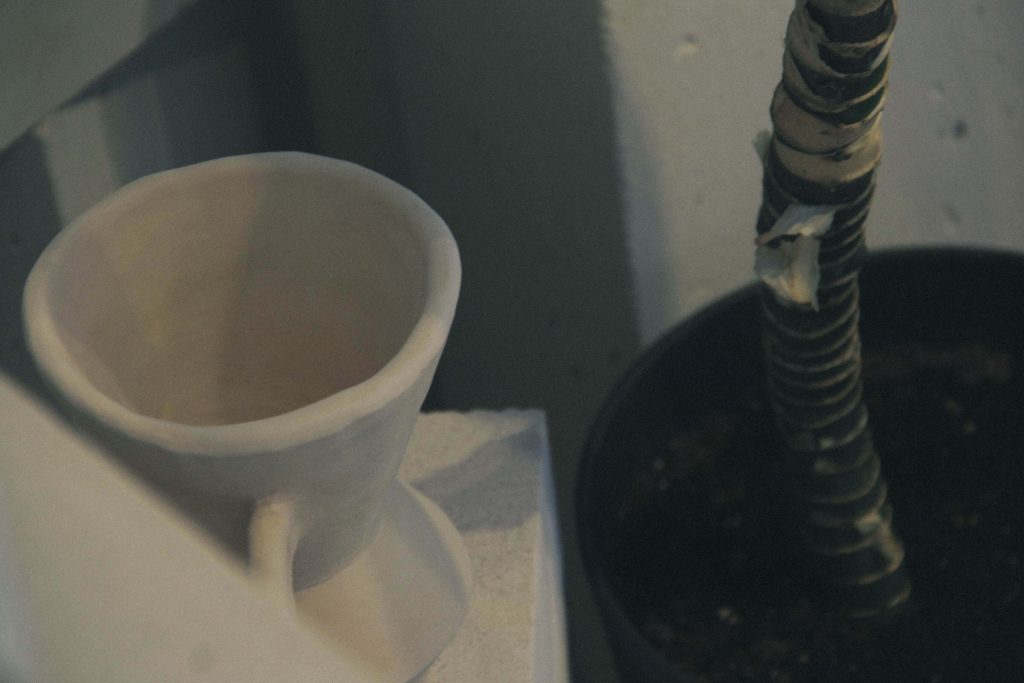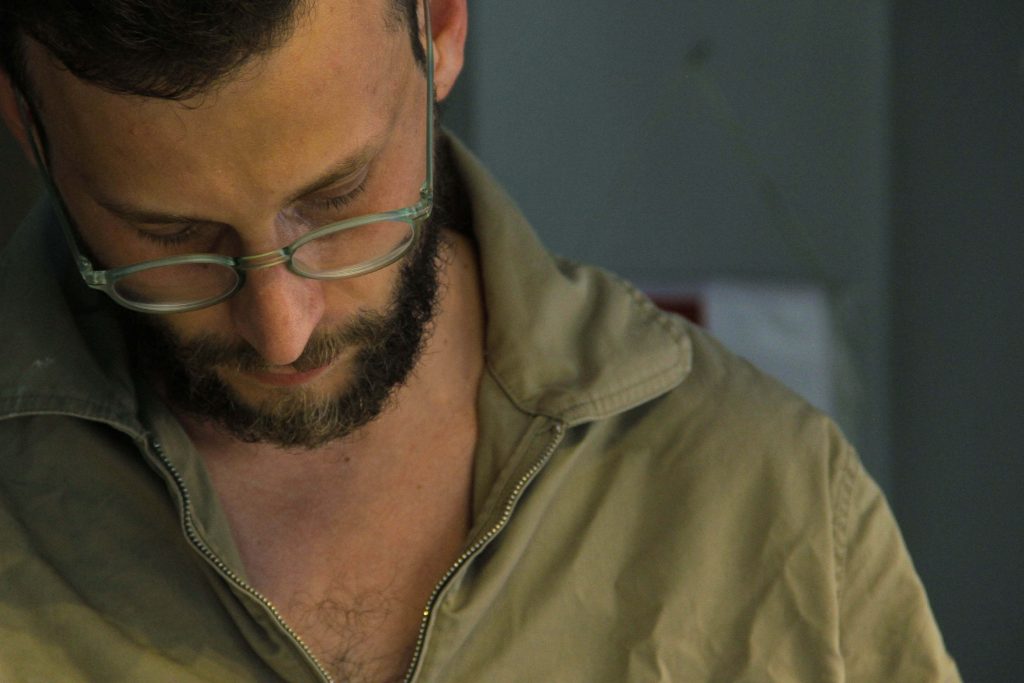In anticipation of his participation at the ‘74Escape STORE & GALLERY in Bodrum, we had the pleasure of visiting Mesut Öztürk ’s studio on the Asian side of Istanbul to view some of his ceramic works in progress, and hear more about his practice.
Rather than a wheel, Mesut Öztürk produces his ceramics using the traditional coiling method. Every resulting vessel hence carries the charm and wonder of being completely handcrafted. His delightful and instantly recognizable Halka Vase Series reinterprets and reimagines vessels of ancient civilizations in pastel colors and contemporary playful forms. First picked up by the 1000 VASES exhibition in Paris and later finding their way to fashion-designer Simon Jacquemus’ restaurant Oursin, the Halka vases are now in high demand, and are currently on show at the Rossana Orlandi gallery in Porto Cervo, as well as of course ‘74Escape in Bodrum!
At his studio, Mesut spoke to us about his production methods, his love and appreciation for ancient vessels, and plans for the future. Read below!
You studied architecture, worked in architectural consulting and then later took a more academic route before deciding to alter your path entirely and delve into ceramics.
What drew you to ceramics, and how do you think your architectural background influences your current practice?
I have always known about myself that I feel fulfilled only at times when I have an area in which I can reflect my individual creativity.. When I started to feel that the practice of architecture and academics no longer provided this space I began searching for something new. The idea of ceramics, which I was familiar with only partially as an architectural material or decorational element came to the forefront repeatedly. As I pondered on the concept further, over time it seemed more and more inevitable that I would meet with ceramics. The opportunity to be so creative through the use of so many alternate techniques, the fact that the practice is essentially healthy and sustainable due to the use of all natural materials, and the mystical atmosphere surrounding the medium due to its ancient past are all important factors that drew me to working with ceramics.
You mentioned that your practice is heavily influenced by historic vessels and the ceramics, pottery and utensils of various cultures that you have had the chance to see in different museum collections.
Can you speak about specific cultures and vessels that have interested you, and some of your favorite collections?
Since my childhood passed in Enez, which was built on the ancient city of Ainos, I grew up surrounded by Ancient Greek and Byzantine ruins. As it happens to be a site where not many archaeological excavations have been carried out, any simple dig could result in finds of ancient pipes, pottery handles and ancient coins. Every home had such small finds scattered around. An interest in ancient sites and artifacts was hence planted at an early age, and I continued to visit ancient ruins and archeology museums on each of my travels. There are certain museums around the world whose collections have been particularly impactful to me. The Museum of Anatolian Civilizations is home to a collection that truly justifies its name, with interesting pieces from all of the ancient civilizations of Anatolia. I found the Hitit Collection especially impressive. As for a reflection of the magical world and civilizations of Mesopotamia, the collection at the Şanlıurfa Archeology Museum has a great collection. The new Trojan Museum on the other hand, presents a good opportunity to get to know Ancient Greek and Hellenistic culture. In Crete, the Heraklion Archeological Museum allowed me to discover the mysterious world of Cretan civilizations. Other than these, the MuCem Mediterranean Civilizations Museum in Marseille, the Louvre, the British Museum, the Berlin Neues Museum and the Berlin Bergama Museum are among some of my favorites.

The Halka Vases have been quickly recognized internationally for their unique forms and pastel colors. They are playful and lighthearted while also referencing prehistoric archeological vessels. Can you briefly describe what this collection explores, and where it is headed as the series continues to develop?
As I dug further into my interest in archeological artifacts , I was more and more affected by the beautiful and interesting forms of historical vessels. Nevertheless, I was somewhat disappointed with the reading material I could find, as the extent was usually very basic or blurry facts. I found the information cold and so disconnected from the mystic wonder they seemed to carry. For instance, gazing at a beautiful and completely unmatched unique form in a museum collection, all I could read on it was ‘Made in xxx B.C., belonging to xyz civilization.” I began to understand slowly that the connection I felt with these ancient artifacts was driving me not to learn more about them in historical terms, but to explore further why their forms were so interesting and striking to me, and to play with producing similar objects. Considering these artworks as functional vessels and tools with a purpose, I felt a new excitement in looking at them. Based on this rich accumulation of images of ancient forms in my mind, I began to develop a diverse and contemporary design language for new ceramic pieces.
With the Halka Vase series, I continue to explore the aesthetics of ancient pottery, through the production of singular forms. Though working with the same visual language, no single form or design is repeated exactly. I have produced 104 Halka Vases so far, and I plan to continue for a while..
Slow production is particularly important to you, and each vase is unique. Tell us about your preference for the coiling method and why for the moment you’re staying away from methods of mass production?
Our culture today is largely based on fast-living, and hence superficiality, on mass-produced products and therefore mass-consumption. I don’t think that this way of life results in true worth or happiness. And at the very least, individually, I’m aiming to slow down my mode of survival. The traditional coiling method of ceramic making requires much patience. It is a slow process that gives way to unique forms that carry the prints and irregularities of handcraft. Working like this is almost a meditation. It also allows me to break the disconnect between design and production, and after the first draft I sketch on paper, I let the form transform and change naturally during production. And in result, with this method, it’s possible to have an object that has been made with care and passion, and that is completely one-of-a-kind.
Who are some other ceramic artists on your radar right now, whose work you enjoy or admire?
Joseph Algieri, Dorothee Loriquet, Fenella Elms, Zhu Ohmu, Elsa Sahal, Bruce Rowe, Eric Roinestad, Simone Bodmer Turner, Ahryun Lee, The Haas Brothers, Ben Medansky, Lucas Ferreira, Lubna Chowdary
You spoke about the desire to work on ceramic wall panels… Can you tell us the origins of the idea and what you hope to achieve?
While walking around the Bağdat Caddesi or Teşvikiye neighborhoods in Istanbul, the ceramic wall panels on the exteriors of the apartments built in the 70s have always attracted my attention. After seeing her wall panels at the retrospective exhibition of Turkish ceramicist Füreya Koral in 2017, I started to think more on this and decided I definitely want to make my own. I also especially like Erdinç Bakla’s panels. The concept is valuable to me in terms of the overlap of architecture and fine art, and I have a few designs in the sketching stage. When the time comes, I’ll at first produce and apply the designs to my own home and studio.
What else is in the works, what do you have coming up? What would you like to be able to devote more time to?
Right now, I’m working on an event that will be staged parallel to the Istanbul Design Biennial in collaboration with In-Between and the Swedish Consulate. At the same time, production of the Halka Vase Series and preparations for upcoming exhibitions are continuing. Besides Halka, I also have a few new ideas in the works, some just concepts I’m pondering, and some that have taken form as preliminary sketches. As the ideas develop further, I’ll begin production.






















